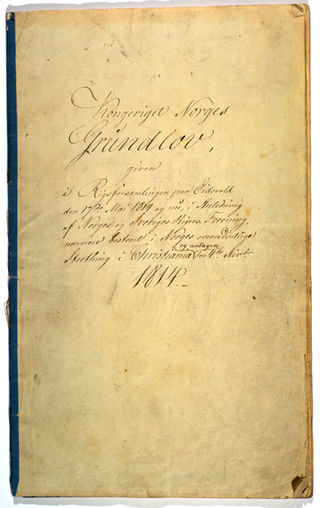
The Constitution of Norway was adopted on 16 May and signed on 17 May 1814 by the Norwegian Constituent Assembly at Eidsvoll. The latter date is the National Day of Norway; it marks the establishment of the constitution.

Sweden and Norway or Sweden–Norway, officially the United Kingdoms of Sweden and Norway, and known as the United Kingdoms, was a personal union of the separate kingdoms of Sweden and Norway under a common monarch and common foreign policy that lasted from 1814 until its peaceful dissolution in 1905.

The Treaty of Kiel or Peace of Kiel was concluded between the United Kingdom of Great Britain and Ireland and the Kingdom of Sweden on one side and the Kingdoms of Denmark and Norway on the other side on 14 January 1814 in Kiel. It ended the hostilities between the parties in the ongoing Napoleonic Wars, where the United Kingdom and Sweden were part of the anti-French camp while Denmark–Norway was allied to France.
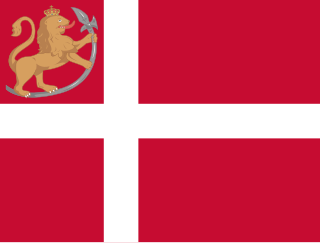
In 1814, the Kingdom of Norway made a brief and ultimately unsuccessful attempt to regain its independence. While Norway had always legally been a separate kingdom, since the 16th century it had shared a monarch with Denmark; Norway was a subordinate partner in the combined state, whose government was based in Copenhagen. Due to its alliance with France during the Napoleonic Wars, Denmark was forced to sign the Treaty of Kiel in January 1814 ceding Norway to Sweden.
The Kingdom of Norway as a unified realm dates to the reign of King Harald I Fairhair in the 9th century. His efforts in unifying the petty kingdoms of Norway resulted in the first known Norwegian central government. The country, however, soon fragmented and was collected into one entity in the first half of the 11th century, and Norway has retained a monarchy since that time. Traditionally, it has been viewed as being ruled by the Fairhair dynasty, though modern scholars question whether the eleventh century kings and their successors were truly descendants of Harald.
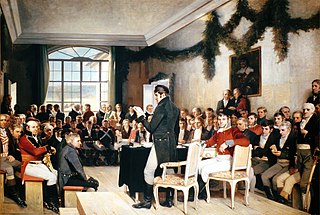
The Swedish–Norwegian War, also known as the Campaign against Norway, War with Sweden 1814, or the Norwegian War of Independence, was a war fought between Sweden and Norway in the summer of 1814. According to the Treaty of Kiel, Norway would enter a union with Sweden under Charles XIII of Sweden. The war resulted in Norway being forced into the United Kingdoms of Sweden and Norway, but with its own constitution and parliament. The war marked the last time Sweden participated in an armed conflict with another nation, and its conclusion signalled the beginning of the country's long period of military neutrality.
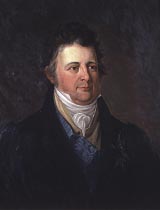
Count Johan Caspar Herman Wedel Jarlsberg was a Norwegian statesman and nobleman. He played an active role in the constitutional assembly at Eidsvoll in 1814 and was the first native Norwegian to hold the post of Governor-general of Norway with the authority of a viceroy, representing the absent king of Norway as head of the Norwegian cabinet during the union with Sweden.
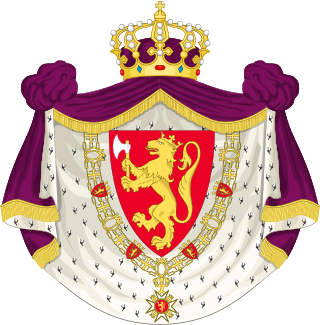
The Norwegian monarch is the head of state of Norway, which is a constitutional and hereditary monarchy with a parliamentary system. The Norwegian monarchy can trace its line back to the reign of Harald Fairhair and the previous petty kingdoms which were united to form Norway; it has been in unions with both Sweden and Denmark for long periods.

The Norwegian Constituent Assembly is the name given to the 1814 constitutional assembly at Eidsvoll in Norway, that adopted the Norwegian Constitution and formalised the dissolution of the union with Denmark. In Norway, it is often just referred to as Eidsvollsforsamlingen, which means The Assembly of Eidsvoll.

The Battle of the Square was a skirmish between Norwegian demonstrators and military forces of the United Kingdoms of Sweden and Norway that took place in Oslo, Norway, on the evening of 17 May 1829.
Events in the year 1814 in Norway.

The Danish state bankruptcy of 1813 was a domestic economic crisis that began in January 1813 and had consequential effects until 1818. As Denmark-Norway struggled with the financial burden that the Napoleonic Wars had on the economy, the devaluation of the currency had negative effects on merchants, citizens and businesses alike.
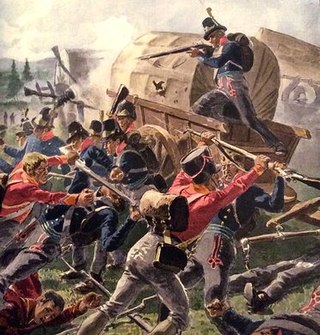
The Battle of Matrand was a military battle on 5 August 1814 between Norwegian and Swedish forces as part of the Swedish-Norwegian War of 1814. The battle took place near the village of Matrand in Eidskog and at Skotterud. It was the bloodiest battle of the entire war, in which the Swedes lost more than 340 men, of which 270 were captured; the Norwegians lost around 50 men with 90 wounded and 36 captured.
The Meeting of Notables was a meeting that took place before Norway declared independence from Denmark in 1814.

The Union between Sweden and Norway is an overriding theme of the history of Sweden in the 19th century. On 4 November 1814, the kingdoms of Sweden and Norway formed a personal union under one king. The two countries had completely separate institutions, except for the foreign service led by the king through the Swedish foreign minister.

The invasion of Hvaler was a Swedish military invasion during the Swedish-Norwegian War of 1814.
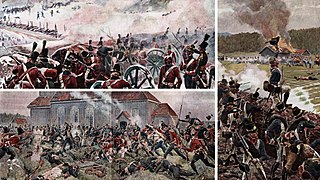
The Dano–Swedish War of 1808–1809 was a war between Denmark–Norway and Sweden due to Denmark–Norway's alliance with France and Sweden's alliance with the United Kingdom during the Napoleonic Wars. Neither Sweden nor Denmark-Norway had wanted war to begin with but once pushed into it through their respective alliances, Sweden made a bid to acquire Norway by way of invasion while Denmark-Norway made ill-fated attempts to reconquer territories lost to Sweden in the 17th century. Peace was concluded on grounds of status quo ante bellum on 10 December 1809.

The Battle of Langnes, or the Battle of Langnes Entrenchment, was fought between Norway and Sweden as a part of the Swedish-Norwegian War of 1814. The battle, even as it ended inconclusively, served as a tactical victory to the Norwegians since they now could avoid an unconditional surrender to the Swedish.

Fredrikstad Fortress, under the command of Nils Christian Frederik Hals, was captured by the Swedish armed forces on 4 August 1814. 207 men remained in the fortress as the Norwegian surrendered to the Swedes; the rest had evacuated earlier. The Swedish casualties were few, 7 men killed and 12 wounded from the army, navy and Archipelago fleet combined.
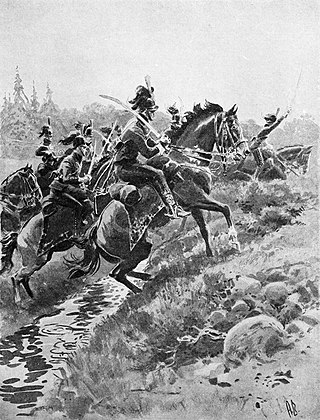
The Battle of Rakkestad was fought in the Swedish–Norwegian War of 1814, at the village of Rakkestad, Norway, between 2,000–3,000 Swedes force under Eberhard von Vegesack, and a slightly smaller Norwegian force, led by Frederik Wilhelm Stabell. The Swedish forces drove the Norwegians back from their fortified positions with a disciplined bayonet-attack and dealt them considerable losses. This battle crippled the morale of the Norwegian defenders, and especially their leader, King Christian Frederik, which contributed to a rapid end of the war, eight days later, with the Convention of Moss.
















